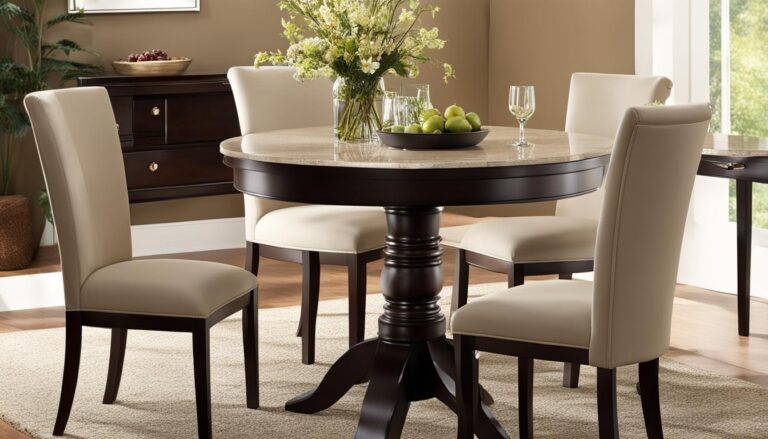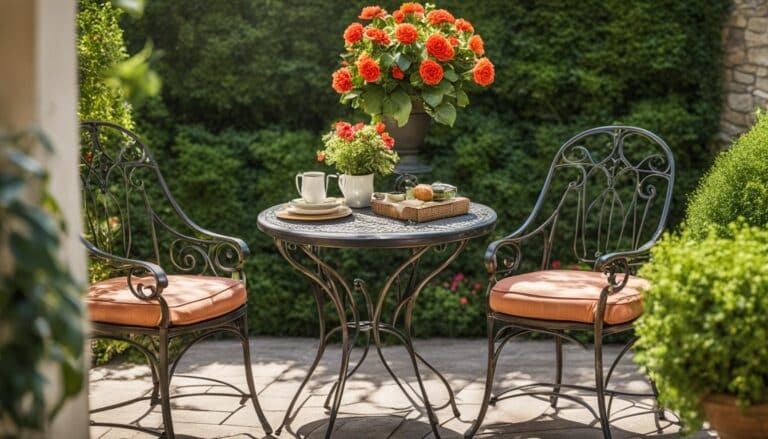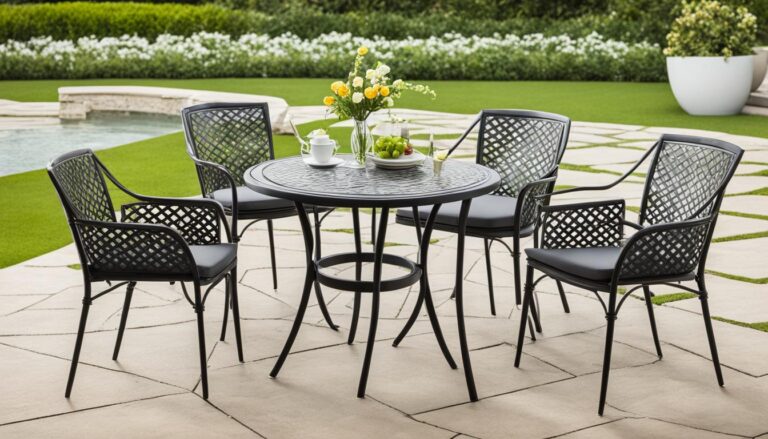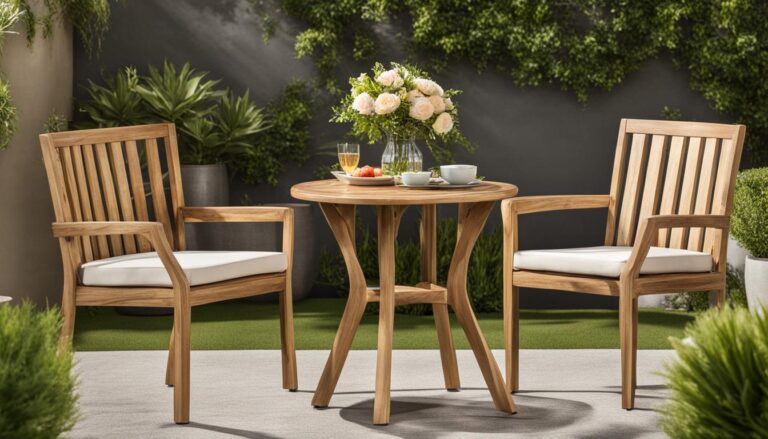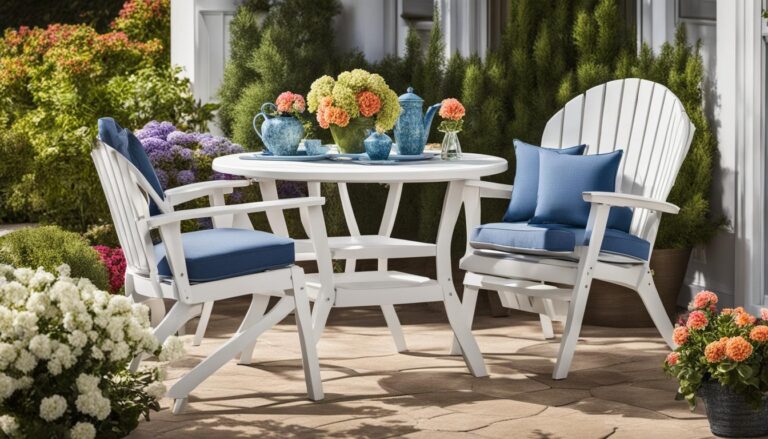If you are lucky enough to own teak outdoor furniture, you know that it is a worthwhile investment. Teak is a durable, weather-resistant wood that is perfect for outdoor use. Over time, however, your teak furniture may begin to look worn and weathered, losing its once-beautiful shine and color. The good news is that with a little effort, you can restore your teak furniture to its original glory.
In this article, we will provide you with expert tips and tricks for restoring your teak outdoor furniture. From assessing the condition of your furniture to cleaning, sanding, and treating it with oil or stain, we will guide you through the restoration process step-by-step. We will also provide advice on repairing and replacing any damaged parts, as well as tips for protecting and maintaining your restored furniture for years to come.
Key Takeaways
- Teak outdoor furniture is a worthwhile investment that can be restored with a little effort.
- Assessing the condition of your furniture is the first step in the restoration process.
- Cleaning, sanding, and treating with oil or stain are essential steps in restoring teak furniture.
- Repairing and replacing parts may also be necessary for a professional finish.
- Maintaining and protecting your restored furniture will ensure its longevity.
Understanding Teak Furniture and Its Maintenance Needs
If you have teak outdoor furniture or are considering purchasing some, it’s essential to understand the special characteristics of this type of wood. Teak is a dense hardwood that contains natural oils, making it resistant to water, insects, and rot. Due to its durability and attractive appearance, teak is commonly used for outdoor furniture.
However, even with its natural strength, teak still requires proper maintenance to keep its appearance and structural integrity. Over time, teak furniture will weather and turn gray due to exposure to the elements. This natural aging process is entirely normal and won’t harm the wood, but it can significantly impact its appearance.
To restore your teak furniture’s original color and beauty, you’ll need to take specific steps to clean and refinish it. The restoration process may seem daunting, but with the right knowledge and tools, it is entirely achievable. Read on to learn more about how to restore your teak outdoor furniture.
Assessing the Condition of Your Teak Furniture
Before you begin the restoration process, it’s crucial to assess the condition of your teak furniture. This will help you identify any structural issues that need to be addressed before proceeding with the restoration process.
Start by examining the furniture for any cracks, stains, or discoloration. Look for any signs of water damage, which can cause cracking and warping of the wood. If your furniture has been outside for a long time, it may have a weathered appearance, which can be beautiful but may also require different restoration techniques.
If you notice any structural issues, such as loose joints or broken slats, it’s important to address them before moving forward with the restoration process. These issues can affect the stability and longevity of the furniture, and may require professional repair or replacement.
Cleaning Teak Outdoor Furniture
If you want to restore your teak outdoor furniture to its former glory, cleaning is an essential first step. Before you get started, make sure you have the necessary supplies, including a soft-bristled brush, a bucket of warm water, and a specialized teak cleaner.
| Step | Instructions |
|---|---|
| 1 | Clear off any loose debris, such as leaves and twigs, from the surface of the furniture. |
| 2 | Mix your teak cleaner with warm water according to the instructions on the label. |
| 3 | Using a soft-bristled brush, apply the cleaner to the surface of the furniture, working in the direction of the grain. |
| 4 | Scrub the furniture gently with the brush. Be sure to get into all the grooves and crevices. |
| 5 | Rinse the furniture thoroughly with clean water, making sure to remove all traces of the cleaning solution. |
| 6 | Dry the furniture with a clean towel, wiping in the direction of the grain. |
Once you’ve finished cleaning your teak furniture, it’s important to let it dry completely before moving on to the next step of the restoration process.
Pro tip: If you have stubborn stains or discoloration on your furniture, you may need to use a specialized teak brightener or stain remover to achieve the best results.
Sanding and Smoothing Teak Furniture
Before treating your teak furniture, it’s important to sand and smooth the surface for the best results. Start by selecting the right sandpaper grit, which typically ranges from 80 to 120. Use a coarse grit sandpaper for heavily weathered furniture and switch to a finer grit for smooth finishes.
Gently sand the furniture in the direction of the grain to avoid causing damage to the wood. Be sure to sand any rough or uneven areas thoroughly to ensure a smooth surface. Once you’ve finished sanding, wipe away any dust or debris with a clean cloth.
If you have grooves or gaps in your teak furniture, you can use a wood filler to even out the surface before sanding. Once the filler has dried, sand the area smooth and wipe away any remaining dust.
Remember to wear protective gear, such as goggles and gloves, when sanding your furniture to avoid injury. And don’t forget to sand carefully around any joints or crevices to avoid damaging the furniture’s structure.
Treating Teak Furniture with Oil or Stain
Now that you’ve cleaned and sanded your teak furniture, it’s time to treat it with oil or stain to bring back its shine. Not only does this step enhance the appearance of your furniture, but it also protects it from harsh weather conditions.
There are a few options for treating teak furniture, including teak oil, tung oil, or a teak sealer. Teak oil is a popular choice as it enhances the natural beauty of teak and creates a protective barrier on the surface. Tung oil is another option that provides a durable finish, but it can darken the wood’s appearance. A teak sealer is a clear, protective coating that is easy to apply and provides long-lasting protection.
Before applying any treatment, make sure your furniture is completely dry and free from dust. Follow the manufacturer’s instructions for the specific product you’ve chosen. Generally, you’ll want to apply the treatment in thin, even coats using a clean cloth or brush. Allow each coat to dry completely before applying the next one.
For optimal protection, it’s recommended to apply a new treatment once or twice a year. This will ensure that your teak furniture stays in top condition for years to come. And don’t forget to protect your furniture from direct sunlight and moisture by using outdoor furniture covers when not in use.
Repairing and Replacing Parts of Teak Furniture
After assessing the condition of your teak furniture, you may find that some repairs or replacements are necessary for a complete restoration. Here are some common issues and solutions:
| Issue | Solution |
|---|---|
| Loose joints | Apply wood glue to the joint and clamp it in place until it dries. You can also use wooden dowels or screws for added support. |
| Broken slats | Remove the damaged slat and replace it with a new one. You can purchase teak slats from a hardware store or online retailer. |
| Other structural issues | Address any cracks, splinters, or other damage with wood filler or by cutting and replacing the damaged section. |
If you need to source replacement parts, look for teak pieces that match in color and grain pattern for a seamless repair. Once the repairs are complete, sand and smooth the affected area to blend it in with the rest of the furniture.
By taking the time to repair or replace any damaged parts, your teak furniture can look and function like new for years to come.
Protecting and Maintaining Restored Teak Furniture
Now that you’ve restored your teak outdoor furniture to its former glory, it’s important to take steps to protect and maintain it. Follow these expert tips to keep your furniture looking great year after year:
1. Protect from the Elements
Teak furniture is naturally resistant to weathering, but it’s still a good idea to protect it from the sun, rain, and other outdoor elements. Consider placing furniture under a covered area or using a furniture cover when not in use.
2. Clean Regularly
Regular cleaning is essential to maintain the appearance of your teak furniture. Use a mild soap and water solution to clean the surface and remove any dirt, dust, or grime that accumulates over time.
3. Avoid Harsh Chemicals
Harsh chemicals, such as bleach or ammonia, can damage the surface of your teak furniture. Stick to mild, natural cleaning solutions and avoid using abrasive brushes or cleaning tools.
4. Oil or Stain Annually
To keep your teak furniture looking its best, it’s important to reapply oil or stain annually. This will help maintain the wood’s natural shine and protect it from the elements. Be sure to follow the manufacturer’s instructions for best results.
5. Store Indoors During Winter
If you live in an area with harsh winter weather, consider storing your teak furniture indoors during the winter months. This will protect it from snow, ice, and other harsh weather conditions that can cause damage over time.
By following these tips, you can ensure that your restored teak furniture remains beautiful and functional for years to come.
Conclusion
Congratulations, you have successfully restored your teak outdoor furniture to its former glory! By following the expert tips and tricks provided in this article, you have ensured the longevity of your furniture and saved yourself the expense of purchasing new pieces.
Remember, routine maintenance is key to keeping your restored furniture looking its best. Regularly clean your furniture, protect it from the elements, and treat it with oil or stain as needed.
Thank you for taking the time to read this article and learn how to restore and maintain your teak outdoor furniture. With a little effort and know-how, you can enjoy your beautiful and functional outdoor space for years to come.
FAQ
Q: How do I restore teak outdoor furniture?
A: Restoring teak outdoor furniture involves several steps such as cleaning, sanding, treating with oil or stain, and repairing or replacing parts if necessary.
Q: Why is teak furniture commonly used for outdoor settings?
A: Teak furniture is popular for outdoor settings due to its natural resistance to weathering, durability, and aesthetic appeal.
Q: How can I assess the condition of my teak furniture?
A: You can assess the condition of your teak furniture by checking for cracks, stains, discoloration, and any structural issues that may need repair.
Q: What is the best way to clean teak outdoor furniture?
A: To clean teak outdoor furniture, use a mixture of mild soap and water, along with a soft brush or cloth, to remove dirt, grime, and mildew.
Q: Why is sanding and smoothing important for teak furniture restoration?
A: Sanding and smoothing teak furniture helps to remove any imperfections, restore its natural shine, and create a smooth finish before applying treatments.
Q: How do I treat teak furniture with oil or stain?
A: You can treat teak furniture with oil or stain by selecting a suitable product, applying it following the manufacturer’s instructions, and regularly maintaining the treated surface.
Q: What repairs or replacements may be needed for teak furniture?
A: Common repairs for teak furniture include fixing loose joints and replacing broken slats. Structural issues should be addressed to ensure the furniture’s stability.
Q: How can I protect and maintain restored teak furniture?
A: To protect and maintain restored teak furniture, it is important to store it correctly, protect it from sun exposure and rain, and regularly clean and maintain its appearance.
Q: What are the key takeaways for restoring teak outdoor furniture?
A: Restoring teak outdoor furniture is a rewarding process that involves cleaning, sanding, treating with oil or stain, and repairing or replacing parts if necessary. It is essential to protect and maintain the restored furniture for longevity and to ensure its continued beauty.


